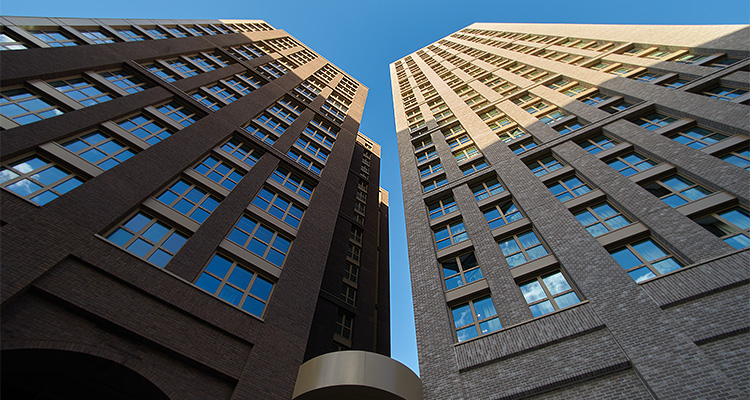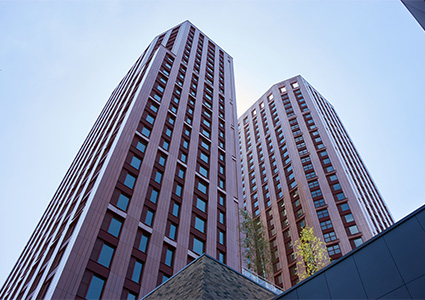
Century Facades Ltd is one of the UK’s most technically competent facade engineering and building contractors
Founded in 2012, Century Facades (Century) specialises in providing fully integrated design, supply, construct and project management packages for complex building facades, often on high rise building (HRB) projects. Remaining privately owned; it has evolved into the fifth largest building envelope contractor in the country.
Construction & Civil Engineering joins Century’s Joint Managing Directors and Co-Owners Graham Hackley and Tim Lovell to find out what has driven the success and growth of the business. “I credit our policy of reinvesting 70 per cent to 80 per cent of our profits year on year back into the business,” begins Tim. “At our core is an absolute drive and determination for excellence and innovation, and to achieve this, very early on we embraced what is quite a radical approach in the form of our graduate training programme. We take talented graduates from the best universities and transform them from recently qualified to true professionals.” 
“Our progression platform is about excellence,” echoes Graham. “We have found that the bedrock of excellence is to bring in very bright young people, with what we describe as ‘curiosity’. We need that curiosity because our industry is changing so quickly, and in an industry that is culturally resistant to change, we need people who are interested in learning about new approaches and not afraid to evolve.”
As well as this recruitment drive, Century has been one of the facade sector market leaders in developing demonstrable competence across the entire business. “Over the past five years or more, our team has either completed a master’s degree in facade engineering, or gained Chartership, to ensure that we meet, and often exceed, the required competences that form part of Building Safety Regulator (BSR) regulations,” explains Tim. “The upskilling of the team has enhanced our technical engineering, which means we can provide robust early-stage advice to our clients, right through to construction stage, including detailed design, engineering, manufacture, and installation.
“If I look back 15 years, our industry didn’t particularly value engineering excellence,” Graham admits. “Few clients cared if staff were chartered and rarely asked to see the CVs of the team. But over the past two-to-three years, there’s been a dramatic change, and the industry has recognised that demonstrable competence is critical. Not only is this welcome, but I think Century can take some credit for it. Thanks to our foresight we predicted this, and we welcome the opportunity to demonstrate our team’s competence.”
In fact, such is Century’s dedication that 80 per cent of its entire team has a degree or master’s in an engineering related subject, and around 90 per cent of the company has achieved cladding training online level one from the CWCT. “This is a statistically brilliant position to be in,” states Graham, “especially when you consider that some of those people are in administration, accounts or finance. It demonstrates that we’re so committed to the technical side, pretty much every staff member is expected to understand the complexities of the product we’re selling.”
Any core ethos of excellence and innovation must include sustainability and once again, Graham notes that this is an area where the industry has seen a massive cultural shift. He describes the new thinking as ‘start at the end and work backwards’ and he sees it as a game-changer. “If you want an entirely sustainable final product, then you must work out exactly what you want the final building to be and then go back through the process one step at a time, ensuring you understand every aspect of what is needed to get there.”
 “Quality assurance now starts with material origin,” adds Tim. “You end up with embodied carbon figures and the full life expectancy of the building, and how it can be recycled at the end of its life. You consider weather cycles, wind loads, the serviceability of products and so on – when that building is handed over to the end user, we have an entire bible of its DNA, from start to finish and beyond. We’re able to tell our clients quite honestly about the environmental and sustainable credentials of a proposed project.”
“Quality assurance now starts with material origin,” adds Tim. “You end up with embodied carbon figures and the full life expectancy of the building, and how it can be recycled at the end of its life. You consider weather cycles, wind loads, the serviceability of products and so on – when that building is handed over to the end user, we have an entire bible of its DNA, from start to finish and beyond. We’re able to tell our clients quite honestly about the environmental and sustainable credentials of a proposed project.”
This process works well with modern methods of construction (MMC), where Century is a pioneer. “We have partnered with the UK’s leading volumetric manufacturer and successfully completed the full facade package on the world’s tallest modular building in London featuring 49 floors of apartments,” says Tim. “Examples of our projects include Enclave, College Rd and George Street in Croydon, and they are iconic, signature buildings that set us apart from our competitors. Our general portfolio is between £5 million and £25 million, and predominantly, our core focus has been on the high-rise building market, above 18 metres.”
Embracing the modular manufacturing approach, Century is focusing on increasing its own in-house manufacturing capacity and has invested in new factory facilities. “Accord Engineering Ltd is a wholly owned subsidiary of Century that has been successfully trading for 50 years,” explains Tim. “Investment at Accord has seen a step change into automation, and this increase in capacity supports Century as a Tier 1 envelope contractor, as well as other third-party clients. We find that maintaining an integral supply chain that can seamlessly adapt to each project, is critical to managing our quality and performance. The industry has a wide range of systemised products that if manufactured in-house, can create a local supply chain and work force.”
Furthermore, experience gained from working on multiple MMC projects puts Century in a strong position to meet the future requirements of the Building Safety Regulator, (BSR), a new body introduced in 2022 as part of The Building Safety Act. Tim and Graham note that while safety is of course a priority for all, the current timeline for approvals through the BSR is threatening the industry. “We can’t forward plan investment because the prolonged approval process is making it hard to gauge what timeline the BSR is working to. This is problematic for everybody,” says Tim.
“The BSR was supposed to deal with applications within 12 weeks, and that timescale was realistic and could allow for necessary changes while still delivering a building on time. But the BSR currently takes more than 40 weeks to decide on 80-to-90 per cent of all applications. This has huge knock-on effects on the delivery window for buildings, as well as making everyone in the process extremely reluctant to make a change, even when reasonable and necessary, and could even save money or be more environmentally friendly.”
Tim and Graham also point out issues with the Gateway process that forms part of the Building Safety Act. “As an industry where traditionally 80 per cent of site instructions and variations are made in the last 20 per cent of the site programme, we are facing the situation that needs to be the other way around. This is because for the last 20 weeks on site, any instruction or variation that might change the design at Gateway 2 is now potentially toxic to practical completion. If it doesn’t achieve Gateway 2, it doesn’t move to Gateway 3, and nobody can move in.
“Gateway 3 occurs at the most financially committed point of a project, and there is a lot at stake because you have a completed building leveraged against financing and it may not be handed over. These sorts of changes are creating turbulence in the market for facade contractors, and while we are all aware of the situation, we’re mindful that we’re not in control of what is happening,” says Tim.
One change that Tim and Graham are calling for the BSR to review is tied to the piling and foundation stage. If decisions could be made prior to Gateway 2 approval, the site could pick up momentum at an earlier stage. “The BSR are talking about building safety, and we would like to discuss if the foundations of a building are connected to building safety in this context,” queries Graham.
The BSA and BSR were changes introduced post Grenfell, plus Covid also brought in new challenges. While based in tragedy, these events spurred innovation that brought improvements across construction. Graham cites quality assurance as an example. “Quality assurance used to be paper documents filed in offices at construction sites, where you were lucky to get 200 photographs of an entire building,” he says. “Today we use the latest technology and on one of our intermediate projects, for example, there might be 20,000 QA sheets signed off by the operatives, with another 40,000 linked photographs. These are submitted via Wi-Fi or 5G, they are with the entire project team within hours and can be sent across the world. Everybody can see what’s happening in every single square metre of building. That’s huge progress and an area where we’re class leading at Century. I don’t think anybody takes it as far as we do.”
“Our QA department is independent of the other departments because they must be non-biased,” Tim continues. “Design is another area where Century shines, as we recognise that design is a function with multiple aspects, so we have over 20 engineers working in three different departments in house: information management, facade engineering and technical submissions, and design composition. These are very much specialist roles, a far cry from the draughts people of old.
“We have also separated the design team from the scheduling team to create a new department. As a result, things are scheduled, checked, batched and procured, to suit both the method of construction and the site programme. We have different departments for different reasons, but over the last 13 years we’ve established a systemised approach as to how we’re best placed to deliver these projects’ complexity.”
Century has always taken a long-term view, ambitiously adopting new approaches, and addressing challenges as they arise. It is now well placed to take advantage of increasing opportunities in the new build BTR and PBSA residential sectors, as well as developing new business in office refurbishment and data centre markets.
“We currently operate generally around London and the South East, and we are exceptionally proud about the projects we’ve completed in these areas. We are now looking to expand into new cities and towns, as part of our ambition to become a national contractor,” concludes Graham. “Our goal is to encourage the construction industry to challenge the status quo and develop modern methods of construction, reducing carbon content and focusing on sustainability, and Net Zero.”
www.centuryfacades.co.uk